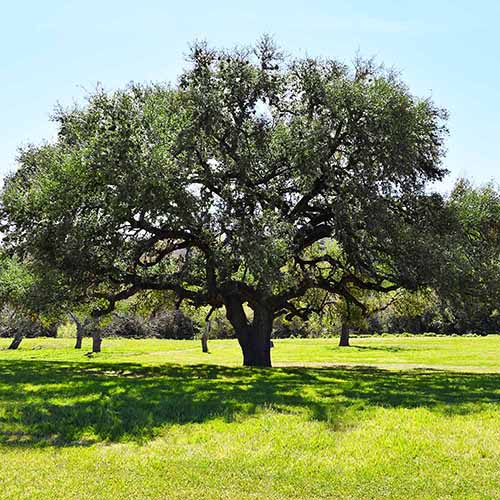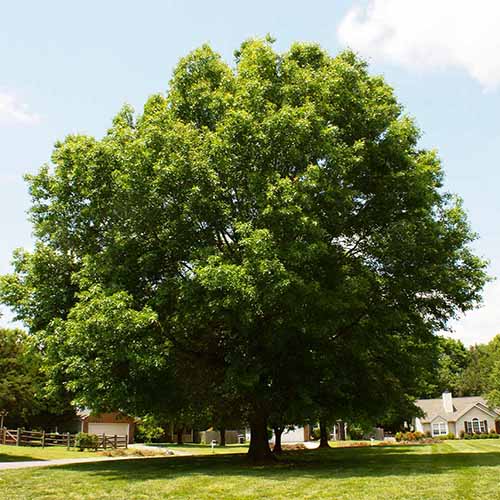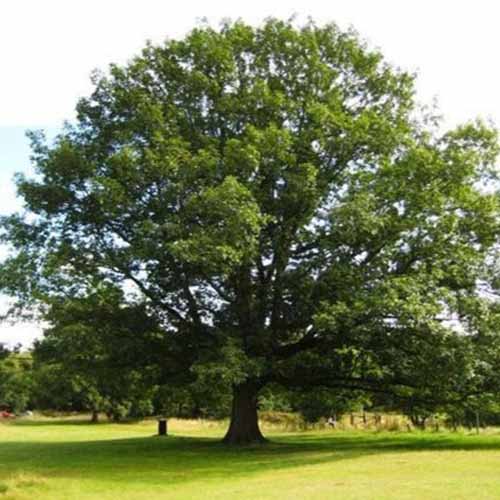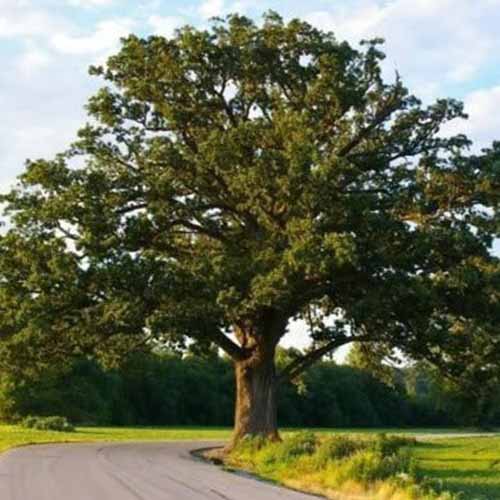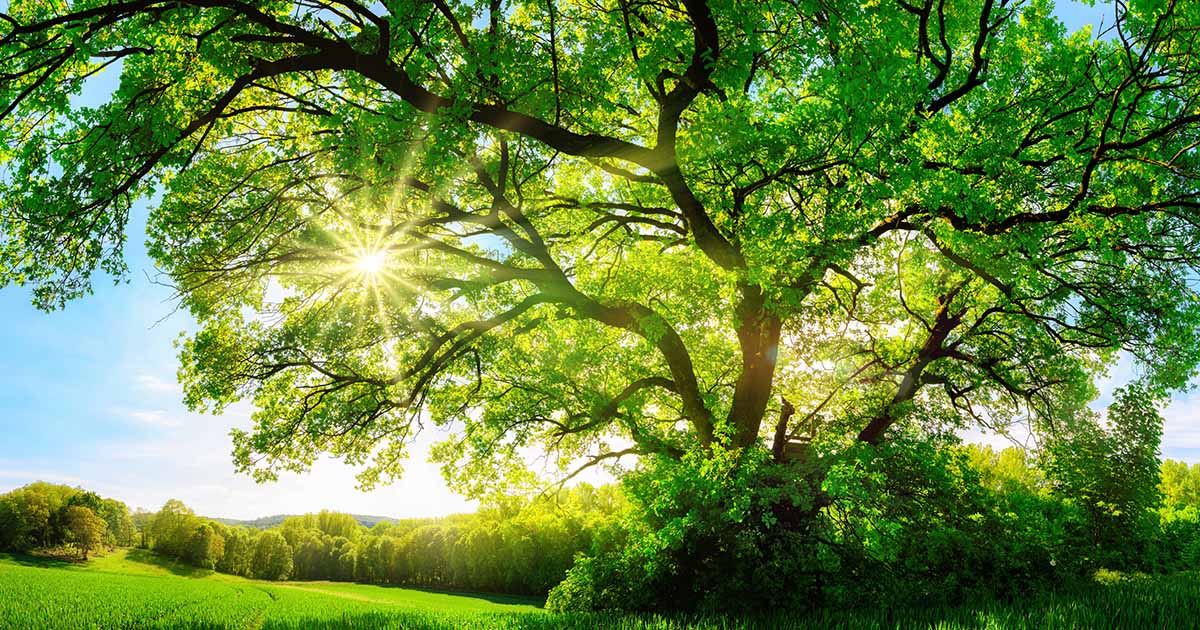
Often referred to as the “king of trees,” the mighty oak is held in high regard for its strength and longevity.
With hundreds of stunning species out there, there’s plenty of options for Quercus fans to choose from and adore.
But how does one tell one species from another? Which varieties are native to North America, and which might be suited to cultivating in the home landscape?
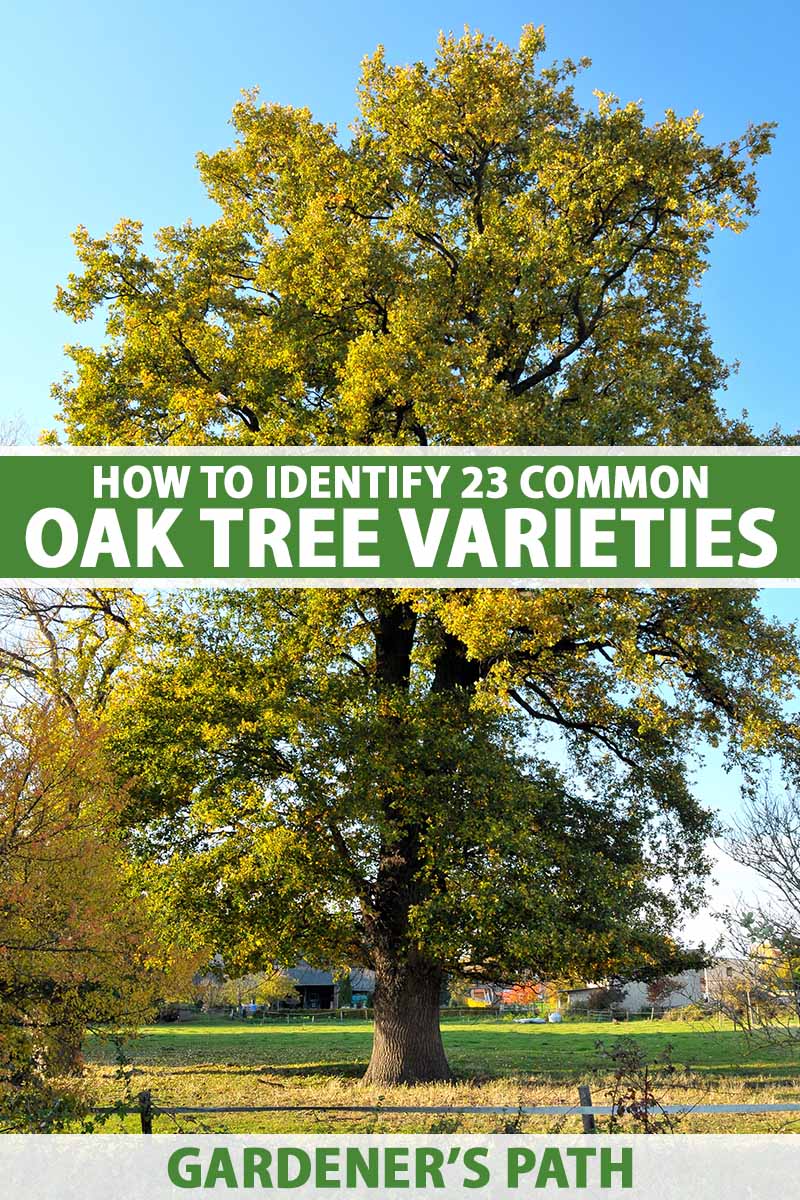
We link to vendors to help you find relevant products. If you buy from one of our links, we may earn a commission.
In my opinion, species of oak are a lot like pasta shapes.
Sure, you could slap the generic name “oak” onto a Quercus just like you could call a bowl of random noodles “pasta,” but it wouldn’t be giving due credit to that specific variety’s awesomeness.
And just like with pasta, being able to tell different types of oaks apart comes in handy.
For general information on growing oak trees, see our guide.
In this article, we’ll go over a handful of the most common oak trees, how to identify them, and what makes them so special.
After reading it, you’ll be able to tell these different species apart at a glance, which will surely impress those not in the know.
23 Common Oak Tree Species
Before we dive into the individual species, let’s go over the two major groups of oaks that species are often divided into: red and white.
Species from the red or Erythrobalanus group usually have bristly and jagged leaf lobe tips, pointed buds, roughly-textured and darker-colored bark, smaller sizes at maturity, and bitter-tasting acorns that take two years to fully mature.
Alternatively, species from the white or Leucobalanus group tend to have wavy and rounded leaf lobes, rounded buds, flaky and lighter-colored bark, larger mature sizes, and sweet-tasting acorns that mature in a single year.
Becoming familiar with these features isn’t enough to differentiate species within these two groups. However, it’s very helpful for quickly ruling out what your Quercus is not.
Here we go!
1. Black
A member of the Erythrobalanus group, Q. velutina has a tall, straight trunk and an open crown that can be rounded or irregular in shape.
Its oval-shaped acorns are reddish-brown and striped, with a tan cap that covers half of the acorn.
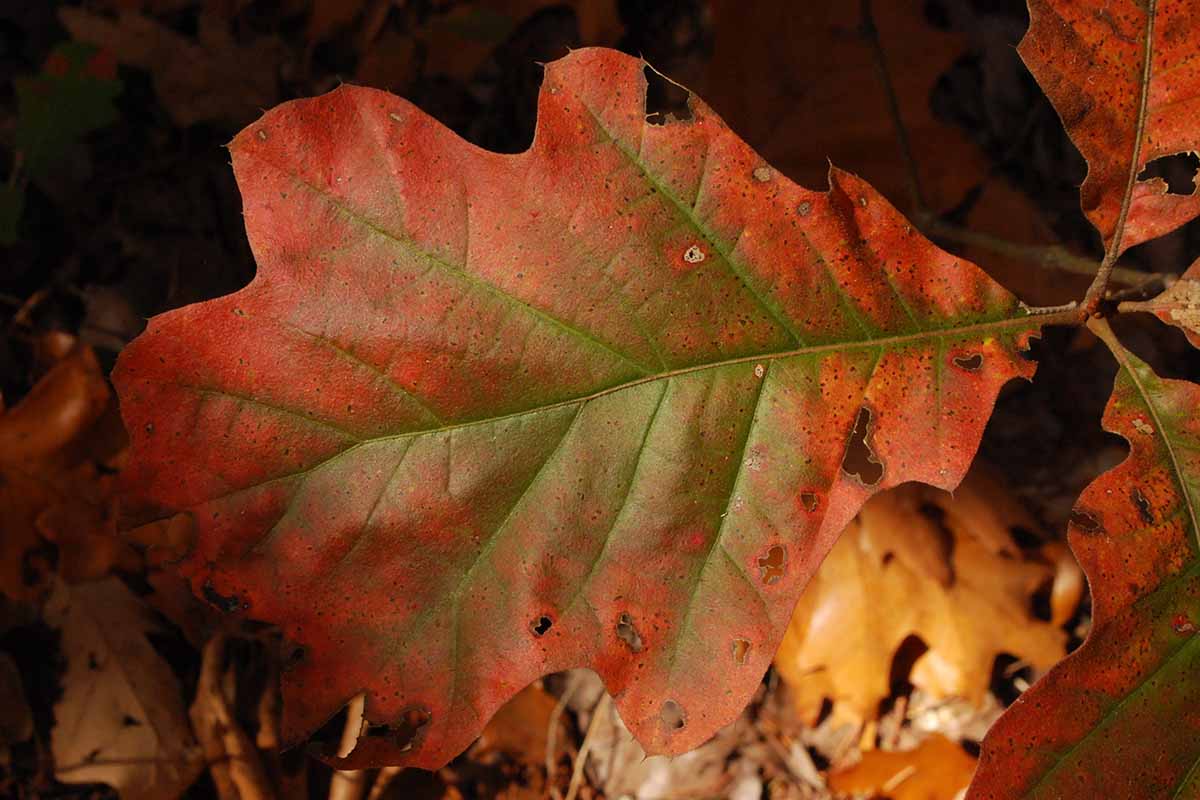
Native to the eastern United States, the tree flaunts lustrous green leaves with seven to nine bristle-tipped lobes and fuzzy undersides.
This velvety texture also coats leaf buds and is a key feature for identification – velutina means “velvety,” after all. Another helpful feature is the black bark at maturity, hence the common name.
Features at a Glance
- Height: 50-60 feet
- Spread: 50-60 feet
- Leaf Length: 4-10 inches
- Leaf Width: 3-8 inches
- Acorn Length: 0.5-0.75 inches
- Bark Color: Black at maturity
- Bark Texture: Deeply furrowed
The black oak isn’t a significant tree in landscaping, but it’s a real aesthetic treat when you find one out in nature!
2. Bur
Also known as the mossycup oak, Q. macrocarpa is a member of the white oak group that hails from northern and central regions of the US, and southeastern Canada.
This tree has a broad, strong crown and rounded, dark green foliage that’s only significantly lobed in the lower half of each leaf.
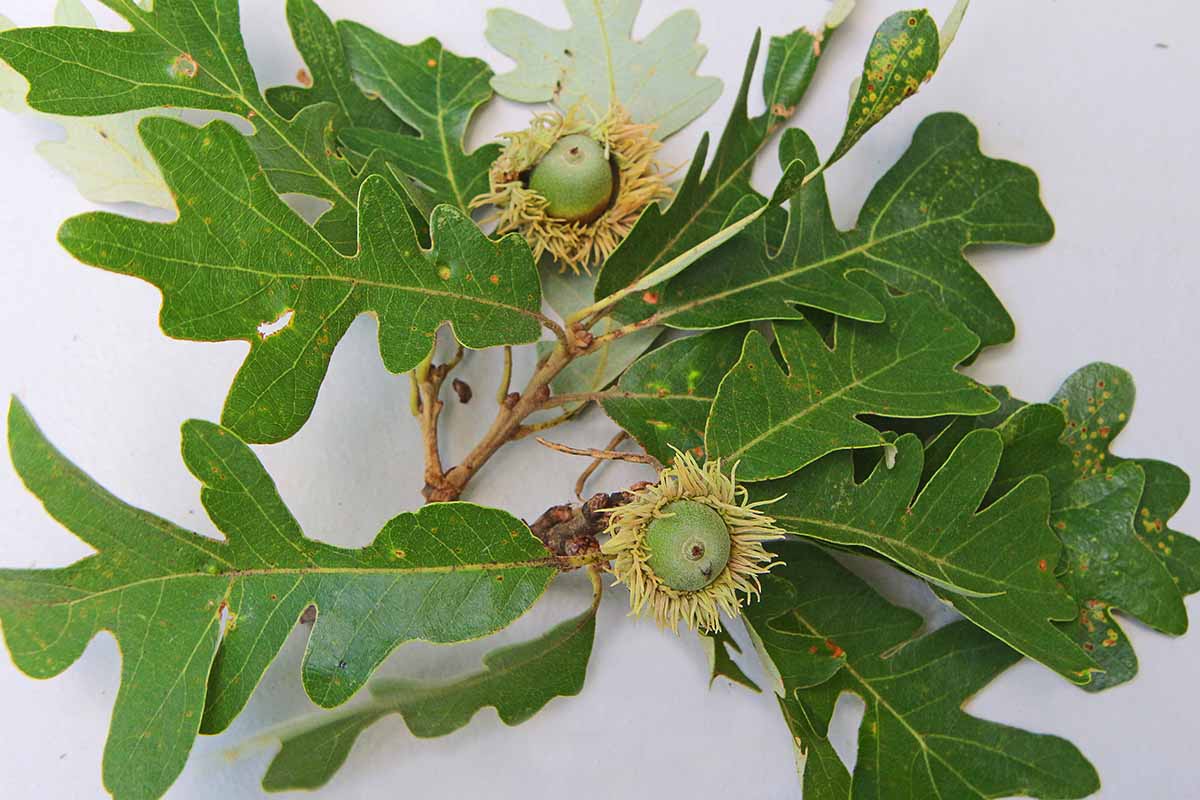
Additionally, it has huge brown acorns – hence the name macrocarpa, or “large fruit” – that are almost entirely covered with tan caps.
These have conspicuously-fringed margins, and each looks a lot like a “mossy cup,” if you will. These acorns and the uniquely-lobed leaves are dead giveaways for Q. macrocarpa identification.
Features at a Glance
- Height: 60-80 feet
- Spread: 60-80 feet
- Leaf Length: 6-12 inches
- Leaf Width: 3-6 inches
- Acorn Length: 0.75-1.5 inches
- Bark Color: Dark gray to gray-brown
- Bark Texture: Deeply ridged and furrowed
As you can imagine, such an interesting tree can be quite valuable. Plant it in USDA Hardiness Zones 3 to 8 with full sun, solid drainage, and moist, fertile soils.
Fun fact: here in Boone County, Missouri, there’s a legendary bur oak known as The Big Tree, a beloved, 400-year-old specimen that’s almost 90 feet tall and 130 feet wide! I’ve had the privilege of seeing it in person, and it’s a big ol’ boy for sure.
3. Chinkapin
Hailing from the eastern United States, Q. muehlenbergii is a member of the white oak group, but it has oblong lance-shaped shiny green leaves with coarsely toothed margins, rather than rounded lobes.
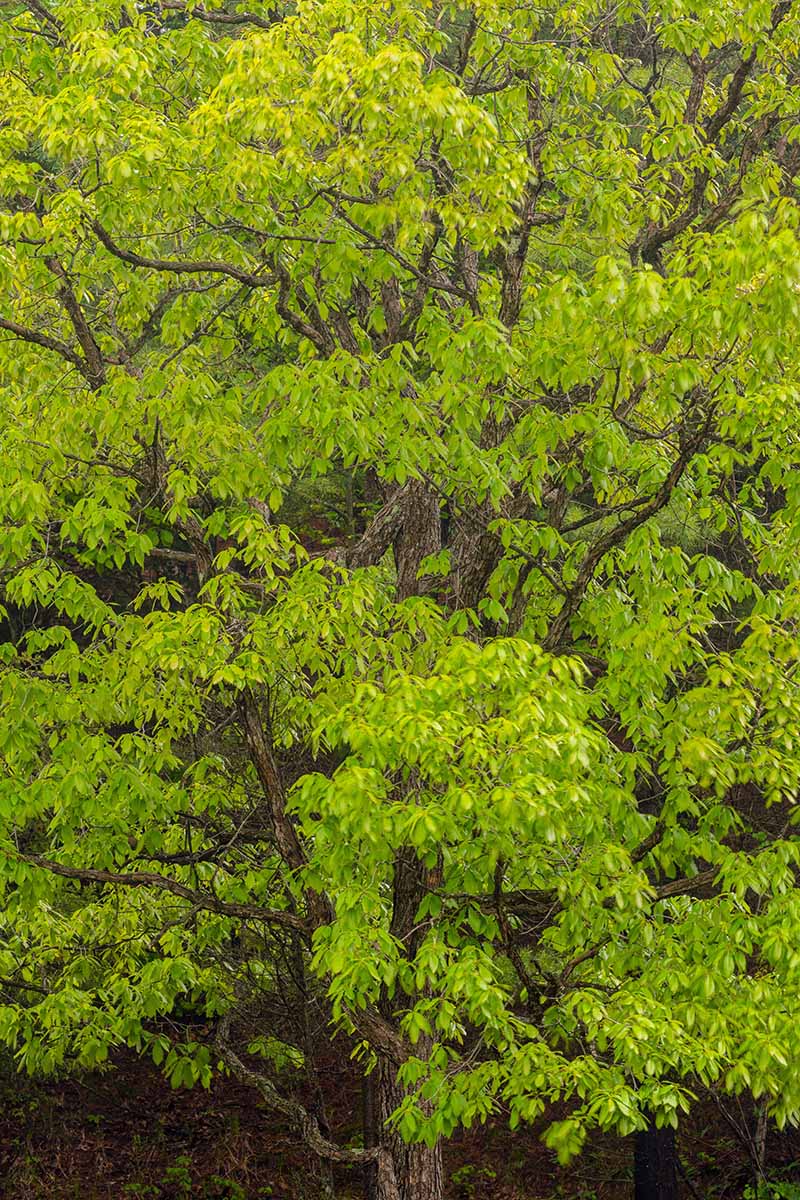
Its crown is open and globe-shaped, and it has small, oval-shaped acorns that mature to black and are halfway covered with tan, scaly cups.
Features at a Glance
- Height: 40-60 feet
- Spread: 50-70 feet
- Leaf Length: 4-6 inches
- Leaf Width: 2-3 inches
- Acorn Length: 0.75-1 inch
- Bark Color: Ash gray
- Bark Texture: Rough and flaky
Trying to add some beautifully-jagged chinkapin leaves to your own landscape? Make sure the tree is given full sun, ample drainage, and a moist, fertile loam in USDA Zones 5 to 7.
Learn more about growing chinkapin oaks in our guide.
4. Columnar
The narrow, fastigiate form of an English oak, Q. robur f. fastigiata is a skinny tree from the Leucobalanus group that flaunts sharply upright branching and densely packed green leaves, with six to 14 blunted lobes and blue-green undersides.
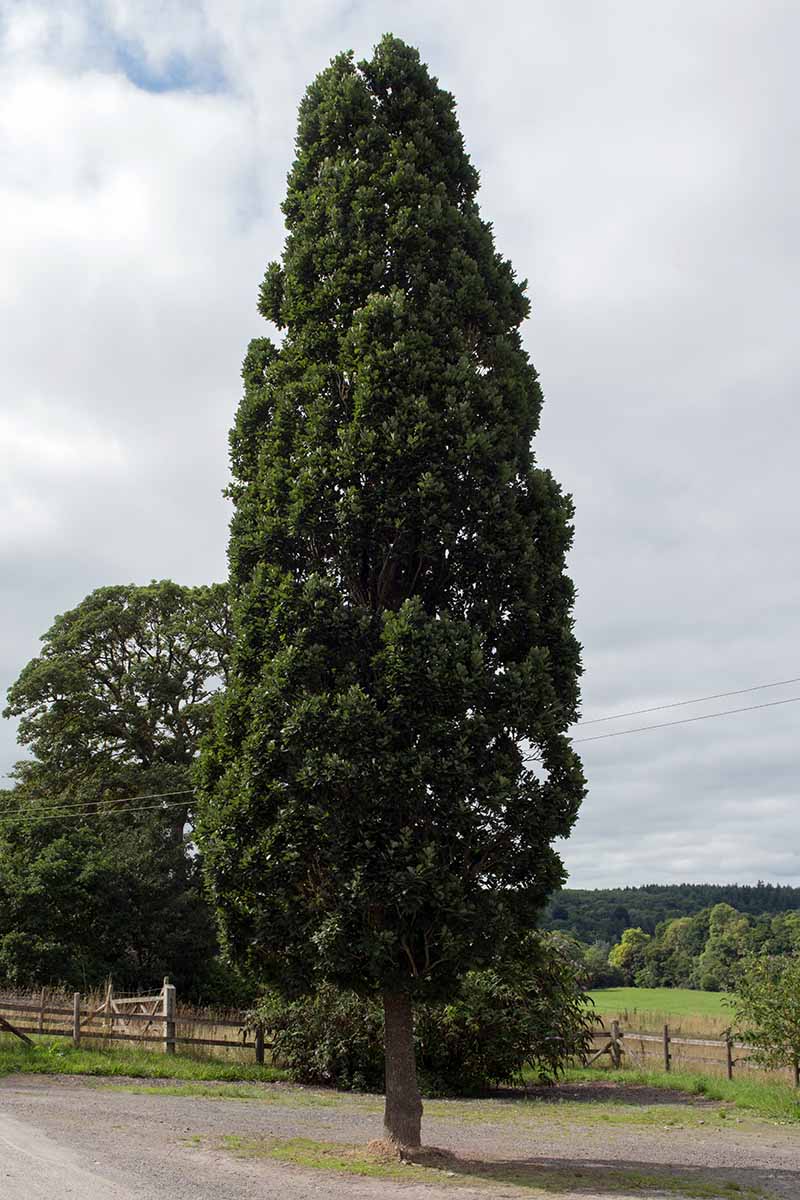
The top third of its shiny, brown, elongated acorns are covered with a tan cap.
Having trouble telling this species apart from Q. alba? Check the base of each leaf for a pair of earlobe-esque lobes, which is a clear sign that these trees are cut from English oak cloth.
Features at a Glance
- Height: 40-70 feet
- Spread: 10-20 feet
- Leaf Length: 2-4 inches
- Leaf Width: 0.75-2.5 inches
- Acorn Length: 1 inch
- Bark Color: Grayish black
- Bark Texture: Deeply furrowed
These trees are hardy in USDA Zones 5 to 8. They grow well in full sun and well-draining soils of average fertility with moderate moisture.
All in all, this is a lanky version of a gorgeous Old World tree that’s perfect for narrow planting spaces!
5. Cork
Q. suber is an interesting entry on our list as it’s the first of the live oaks, which are species of Quercus with evergreen leaves.
And as such, live oaks such as Q. suber don’t fit into the deciduous red or white groups.
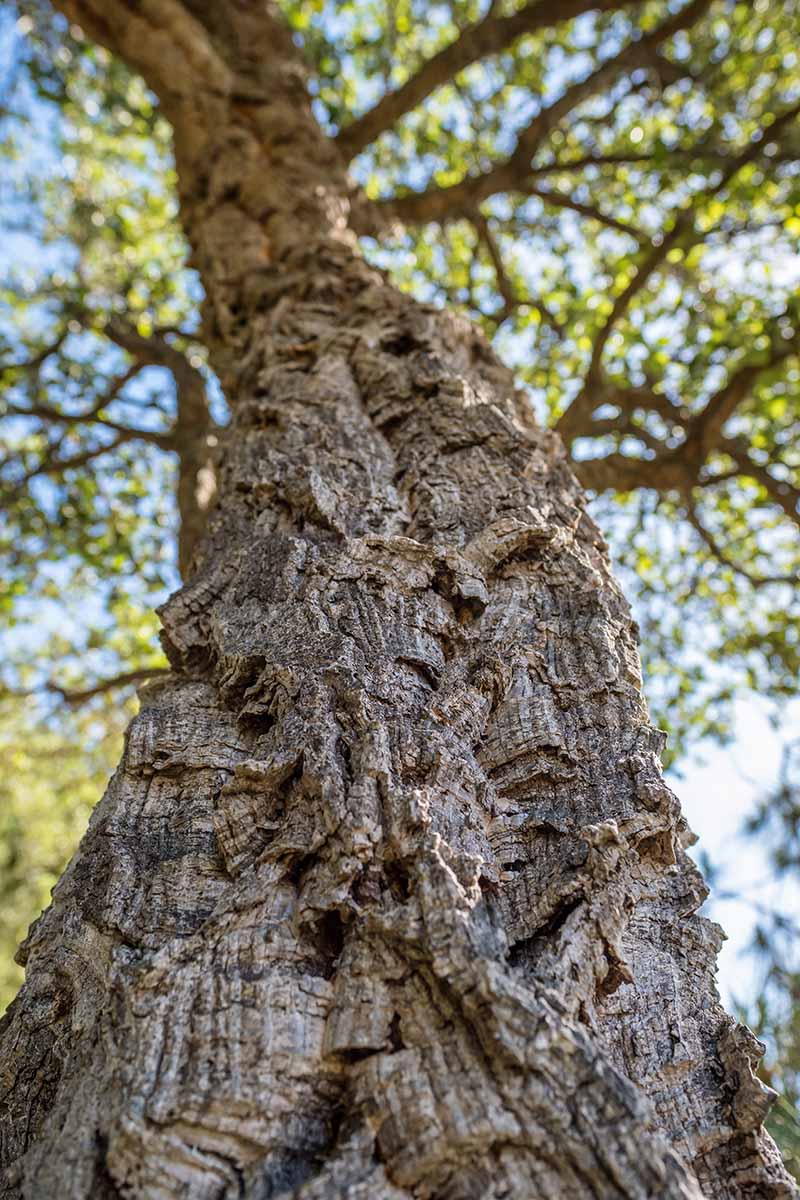
Native to northern Africa and southern Europe, the cork oak has dark green, oval-shaped, wavy-toothed, leathery leaves of a shiny, dark green hue. Additionally, it flaunts long, tan-capped, and red to black acorns.
The tree is named for its thick and corky bark, which is cultivated in Europe and Africa for its commercial applications in wine bottle corks and the like.
This bark, in combination with the evergreen leaves, are how you spot Q. suber.
Features at a Glance
- Height: 40-70 feet
- Spread: 40-70 feet
- Leaf Length: 2-4 inches
- Leaf Width: 1-3 inches
- Acorn Length: 1.25 inches
- Bark Color: Reddish-brown
- Bark Texture: Corky, deeply fissured
Corky utility aside, it’s also a splendid street tree, park planting, or suitable option to provide shade for a residence.
Make sure it’s situated in USDA Zones 8 to 10, given full sun to partial shade, watered little, and provided with acidic loam to grow in.
6. Holly
Another live oak with evergreen foliage, Q. ilex flaunts a rounded crown that branches pretty close to the ground for a Quercus.
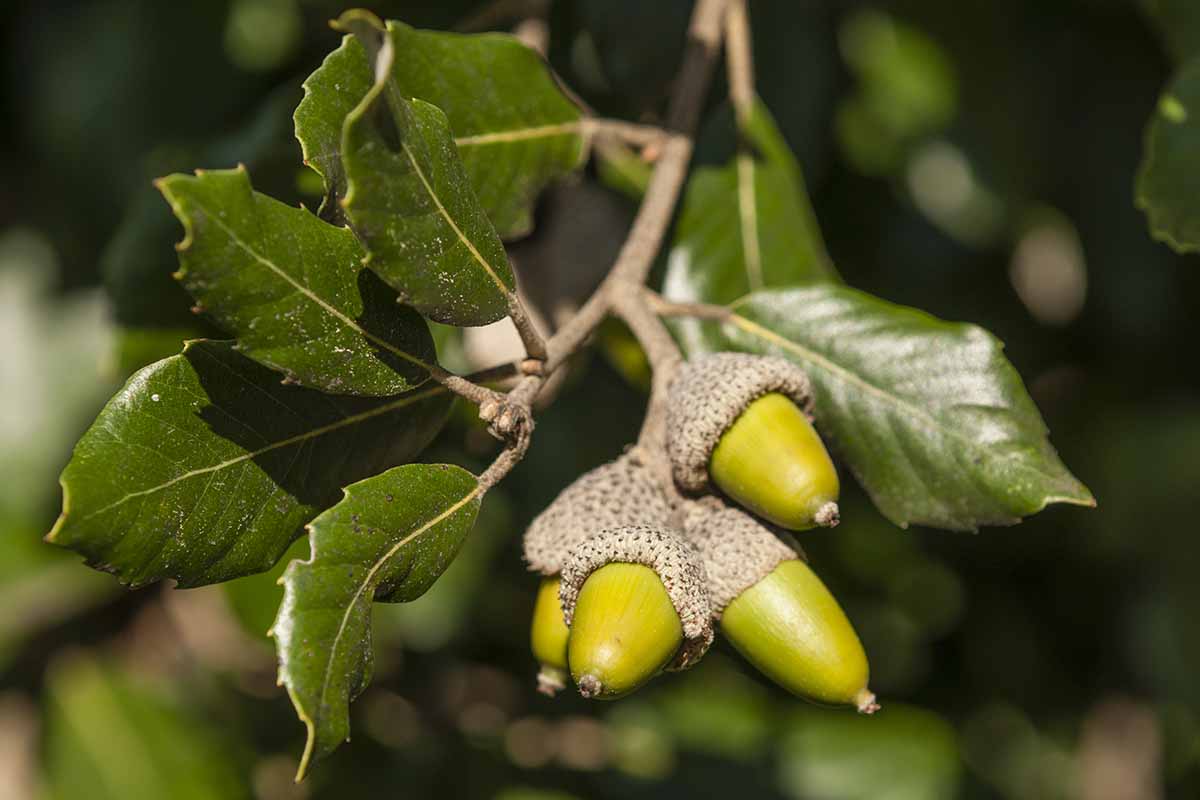
Native to the Mediterranean, holly oaks have dark green leaves that resemble holly, hence the common name.
Its large acorns are long, with gray caps that cover a third of the dark red to brown nuts.
Features at a Glance
- Height: 40-70 feet
- Spread: 40-70 feet
- Leaf Length: 3-5 inches
- Leaf Width: 1 inch
- Acorn Length: 0.75-1.5 inches
- Bark Color: Gray
- Bark Texture: Smooth to fissured
The Ilex-like leaves are the most helpful clue for picking this species out of a lineup.
If you’ve ever wanted holly-like foliage paired with the wood of a Quercus, you can’t do better than the holly oak.
For any interested growers, this species is hardy in USDA Zones 7 to 10 and needs to be situated in a rich and moist loam with full sun to partial shade exposure.
7. Live
Just as Q. alba and Q. rubra are the flagship species for the Erythrobalanus and Leucobalanus groups, Q. virginiana is the poster child among evergreen live oaks.
To avoid confusion with other species, the common name “southern live oak” comes in handy here.
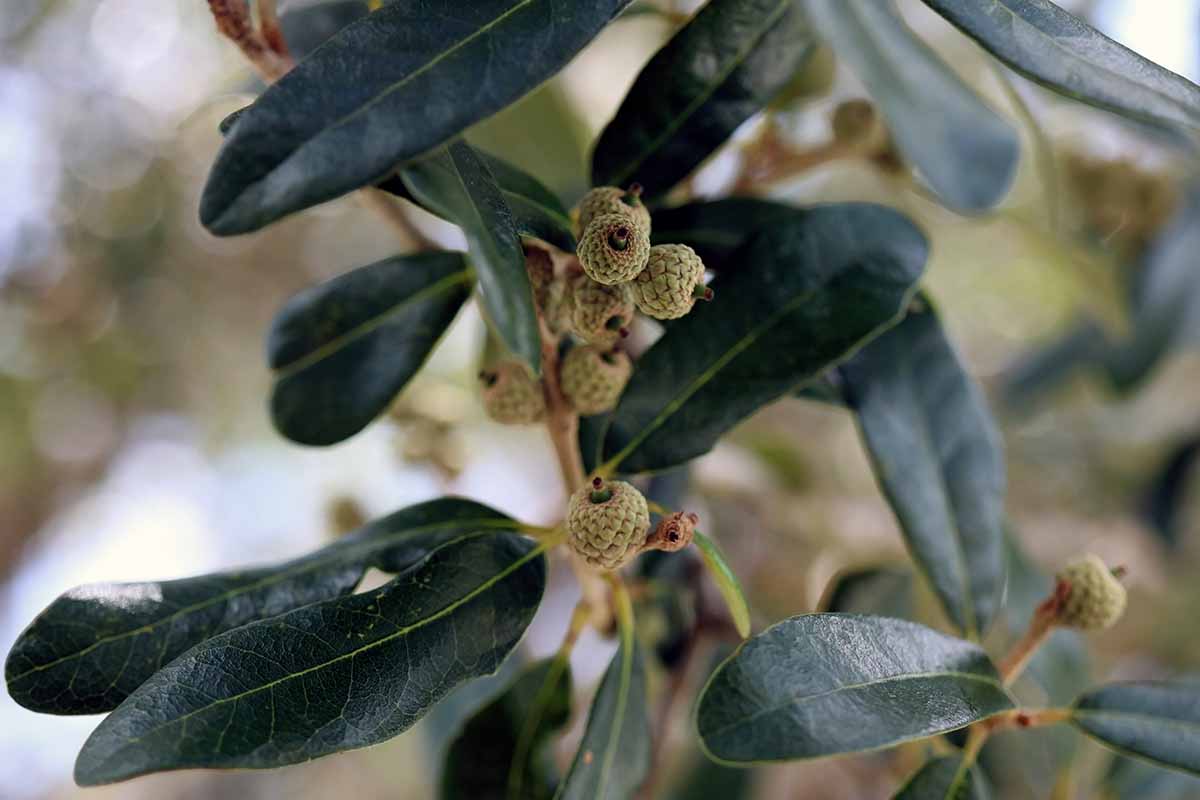
Native to the southeastern US and Mexico, the southern live oak is an evergreen Quercus that branches low, spreads wide, and is often found draped with Spanish moss in its native range.
This tree has leathery, glossy, and elliptical-shaped leaves of a dark green hue, with smooth margins that are rather uncharacteristic for a Quercus.
Its acorns are long and extremely dark, with tan caps that encase the top third.
A symbolic planting of the American south, this tree is often found lining the long driveways of Southern-style mansions and former plantations.
I’m pretty sure Q. virginiana provided the backdrop for many scenes in “Django Unchained,” but it’s been a minute since I’ve seen that movie.
Features at a Glance
- Height: 40-80 feet
- Spread: 60-100 feet
- Leaf Length: 1.25-5 inches
- Leaf Width: 0.5-1.5 inches
- Acorn Length: 1 inch
- Bark Color: Dark gray
- Bark Texture: Alligator-like
If you want to cultivate one, be sure to grow it in USDA Zones 8 to 10, place it in well-draining soil, and provide it with moderate moisture and full sun.
This tree is especially long-lived for an oak, so any hopeful growers and their descendants will be sure to enjoy it for years to come!
Live Q. virginiana transplants are available from FastGrowingTrees.com.
8. Mexican White
A Mexican native oak, Q. polymorpha is a member of the Leucobalanus group, with a broad and rounded crown.
The species epithet polymorpha refers to the way that individual leaves vary in form among and between individual specimens.
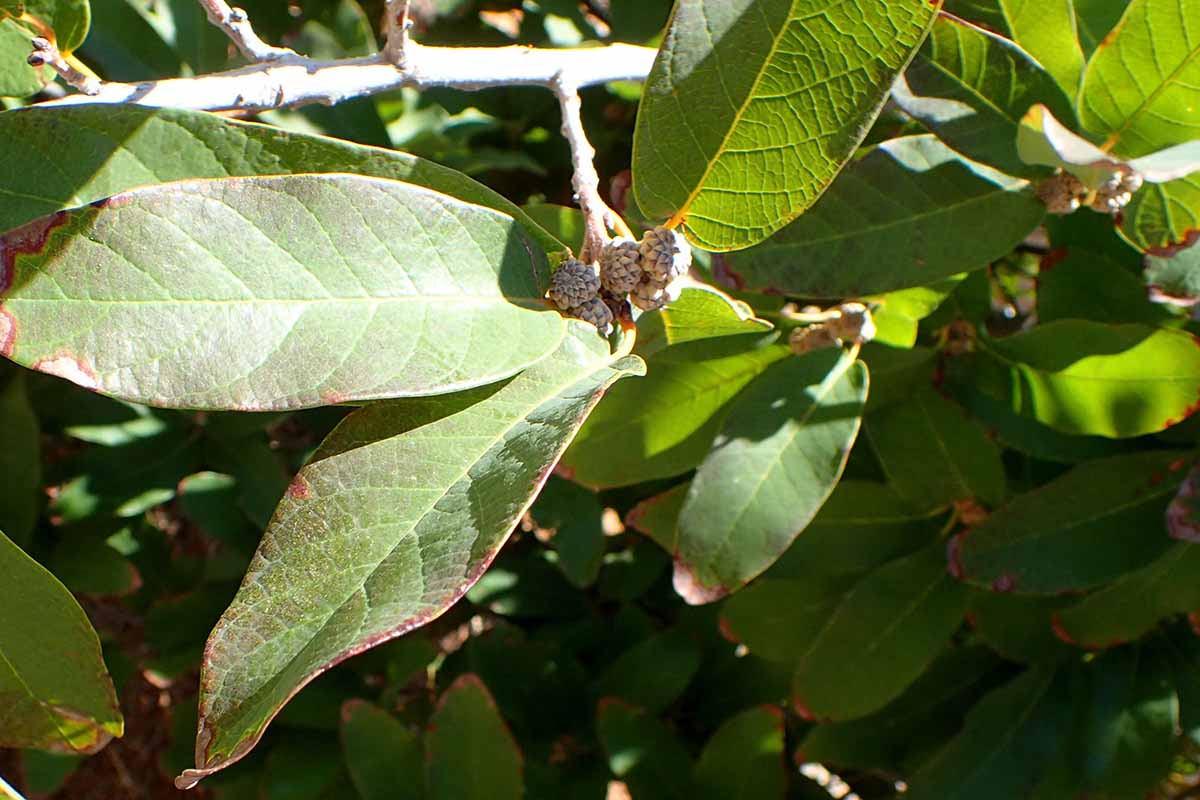
In general, these verdant and ovate leaves are semi-evergreen, with margins that vary in smoothness and serration.
This tree also produces light brown acorns that are covered halfway with a light gray cap.
Features at a Glance
- Height: 40-60 feet
- Spread: 30-40 feet
- Leaf Length: 4-5 inches
- Leaf Width: 2-3 inches
- Acorn Length: 1 inch
- Bark Color: Gray
- Bark Texture: Ridged and exfoliating
This fast-growing tree is the fantastic and novel Quercus to add to a garden in USDA Zones 7 to 10.
If you want to cultivate one of your own, make sure to put it in a full sun location with well-draining soil, and be sure to read our guide to Mexican white oaks to learn more.
9. Nuttall
Also known as Q. texana, the Nuttal oak hails from the southern and central regions of the United States, and is a wide-spreading, rounded, and open-canopied member of the Erythrobalanus group.
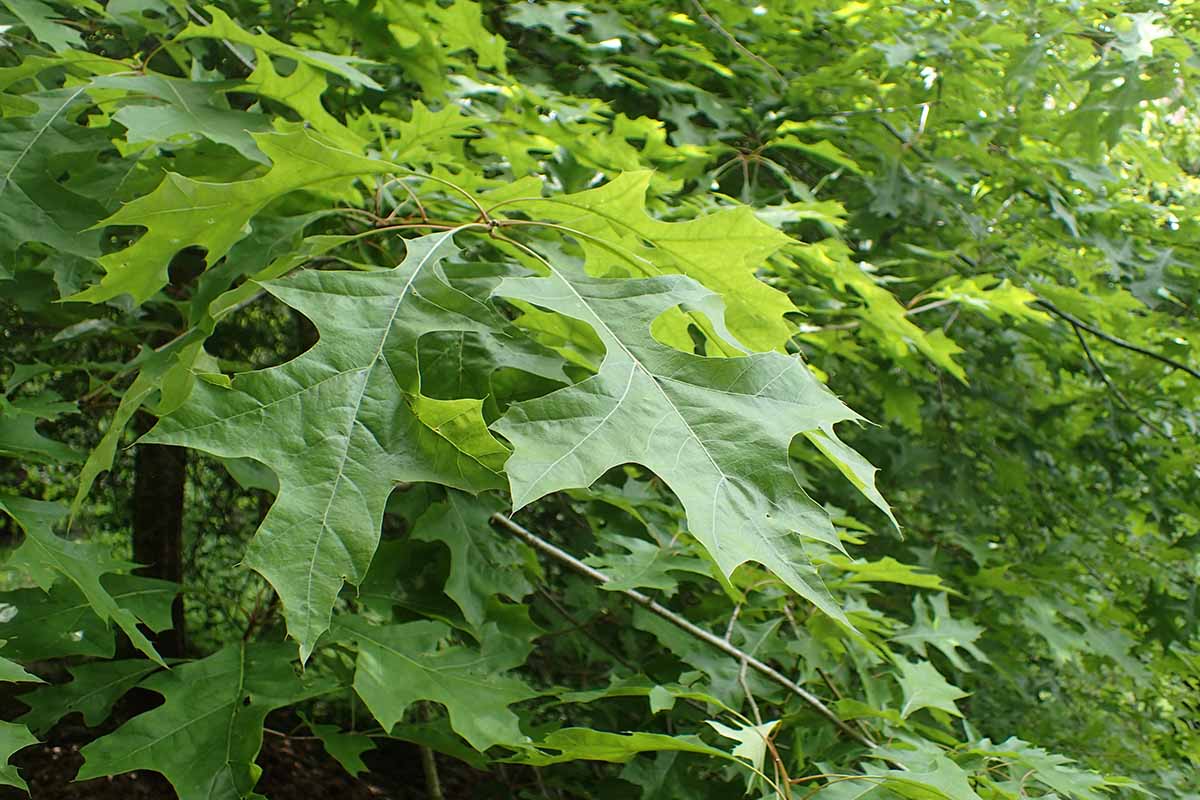
Its bright green leaves have five to nine bristly lobes with deep, wide gaps between them, and the tree produces brown, striped acorns that are covered a bit less than halfway with tan caps.
Features at a Glance
- Height: 50-80 feet
- Spread: 40-65 feet
- Leaf Length: 4-9 inches
- Leaf Width: 2-5 inches
- Acorn Length: 0.75-1.25 inches
- Bark Color: Medium to dark gray
- Bark Texture: Smooth to furrowed
The tree’s beauty and cultural toughness make it a fine addition to landscapes.
To add one to yours, make sure it’s planted in USDA Zones 6 to 9 with full sun. Moist, rich loam is ideal, though it can tolerate a variety of soil types.
Nuts for Nuttall oak? It’s available in one- and three-gallon sizes from Perfect Plants Nursery.
10. Overcup
An oak from the Leucobalanus group, Q. lyrata hails from the central and southern United States, often found growing in bottomlands.
With a rounded habit and uniform branching, these trees look especially nice in a row or group.
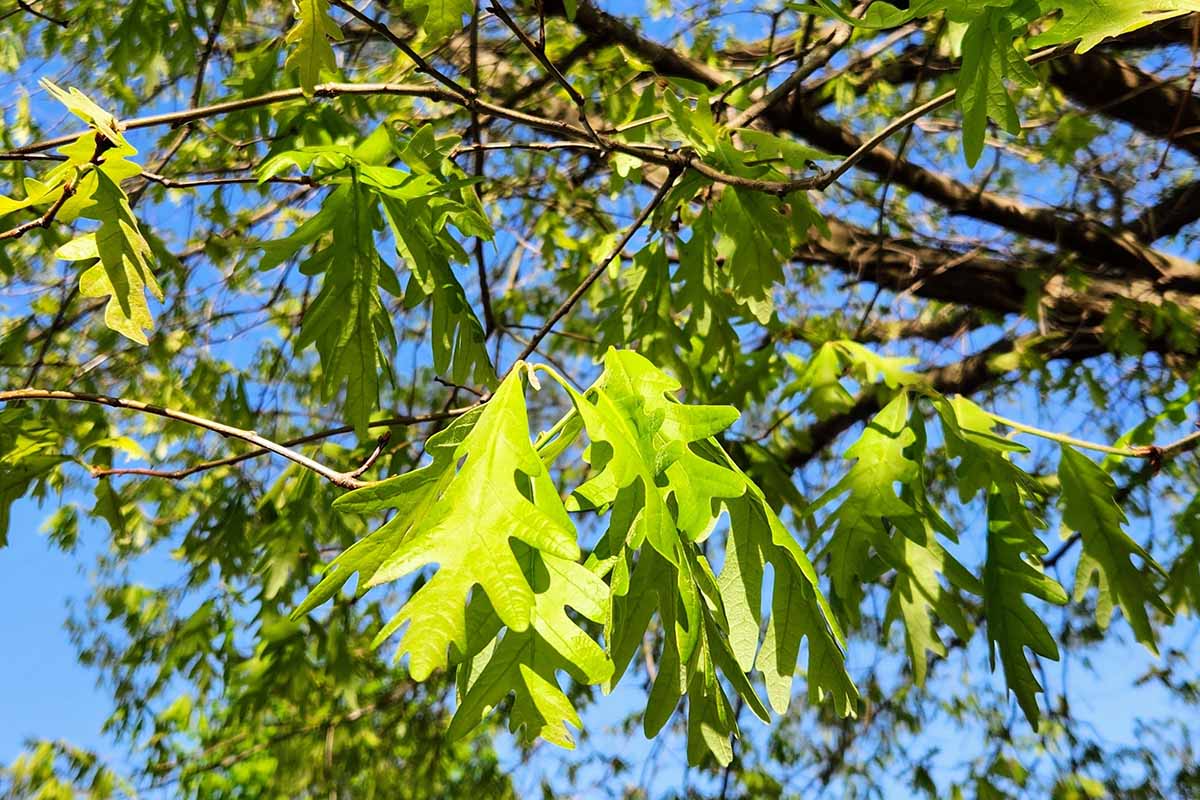
The deep green leaves have fuzzy white undersides and six to 10 bluntly pointed lobes, with the largest pair in the middle.
The brown acorns are rounded, and almost completely encased by their tan caps.
Features at a Glance
- Height: 40-60 feet
- Spread: 40-60 feet
- Leaf Length: 6-8 inches
- Leaf Width: 1.5-5 inches
- Acorn Length: 0.75-1 inch
- Bark Color: Gray
- Bark Texture: Fissured
Fast and uniform growth, ease of transplanting, and tolerance of shoddy soils all make this a worthwhile planting in USDA Zones 5 to 9.
Make sure to provide full sun and moist, acidic loams for optimal growth.
11. Pin
Also known as Q. palustris, pin oaks are a layup, identification-wise.
Native to the northeastern United States and southeastern Canada, these members of the red oak group have a broad pyramidal crown and branches that are ascending towards the top, somewhat horizontal towards the middle, and descending towards the bottom.

Each glossy, dark green leaf is thin and has five bristly lobes with very deep gaps between them, creating the appearance of super slender foliage even though the leaves themselves aren’t small.
The acorns have super shallow tan caps, and the nuts themselves are light brown with a nearly round, domed shape.
Features at a Glance
- Height: 50-70 feet
- Spread: 40-60 feet
- Leaf Length: 3-6 inches
- Leaf Width: 2-5 inches
- Acorn Length: 0.5 inch
- Bark Color: Grayish brown
- Bark Texture: Slightly ridged
The distinctive growth habit, leaves, and acorns all combine to make this tree a very popular commercial planting, for open landscapes and urban areas alike.
Full sun and a moist, loamy planting site in USDA Zones 4 to 8 are recommended.
Interested in this tree? Four- to seven-foot pin oaks are available from FastGrowingTrees.com.
12. Post
A member of the white oak group, Q. stellata is a rounded and densely-crowned tree that’s native to the eastern United States.
The durable wood of this tree was valued by pioneers and often used for fence post construction in the late 18th to early 19th century, hence the name.
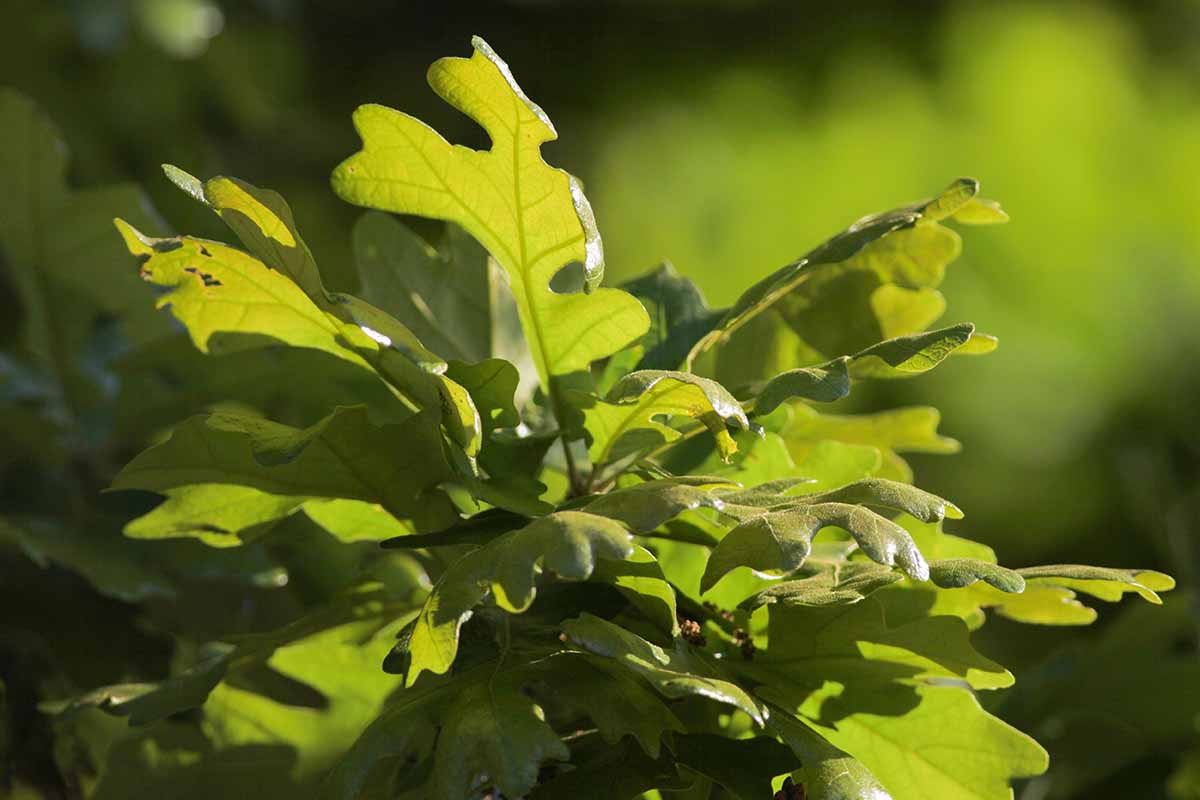
The dark green, roughly-textured leaves of this plant have three to five extremely rounded lobes, with narrow, slitted sinuses between them.
The acorns produced are oval-shaped, with tan caps that cover half to a third of the brown nuts.
Features at a Glance
- Height: 35-50 feet
- Spread: 35-50 feet
- Leaf Length: 4-8 inches
- Leaf Width: 3-4 inches
- Acorn Length: 0.75-1 inch
- Bark Color: Gray
- Bark Texture: Ridged
This tree is rarely used in the landscape, but is quite attractive when stumbled upon out in the wild.
13. Red
As red oak-y as they come, Q. rubra wields a rounded, symmetrical to irregular crown.
A native of eastern North America, this tree flaunts glossy dark green leaves with seven to 11 bristly-toothed lobes and shallow leaf sinuses.
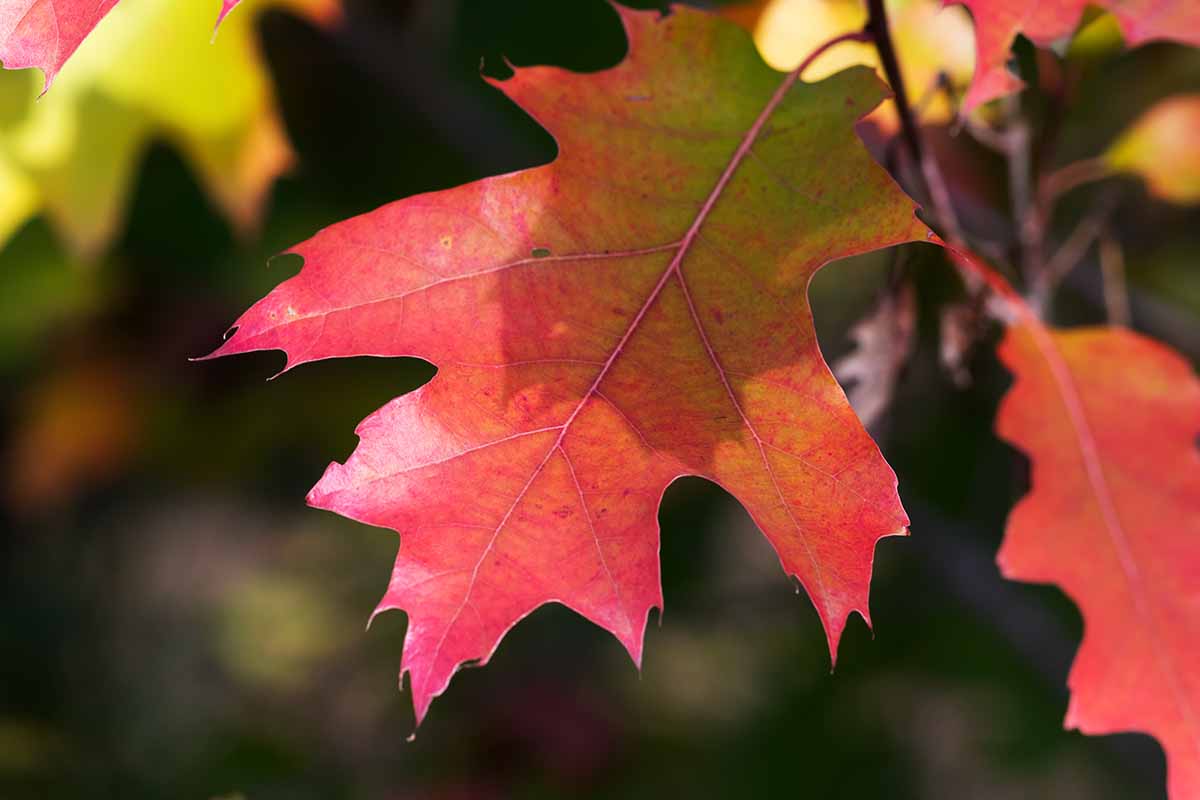
A light brown cap that looks suspiciously like a beret covers the top quarter of the gray-streaked brown acorns.
Features at a Glance
- Height: 50-75 feet
- Spread: 50-75 feet
- Leaf Length: 4.5-8.5 inches
- Leaf Width: 4-6 inches
- Acorn Length: 0.75-1 inch
- Bark Color: Gray
- Bark Texture: Shallowly fissured
A speedy grower fit for golf courses, streets, and parks, Q. rubra is an easy tree to cultivate, provided that you’re located in USDA Zones 4 to 8, provide full sun, and put it in well-draining and fertile sandy loams.
If you wish to grow one of your own, starting sizes of four to seven feet are available from PlantingTree.com.
14. Sawtooth
North America has the largest number of native oak species, but they come from other continents, too. Take the Asian Q. acutissima, for example – it hails from Japan, China, Korea, Thailand, and the Himalayas.
Believe it or not, there’s also a “Cerris” group of Quercus, a section of species with traits that straddle the line between the red and white oak groups. It’s in this group that Q. acutissima belongs, with its broad, rounded habit.
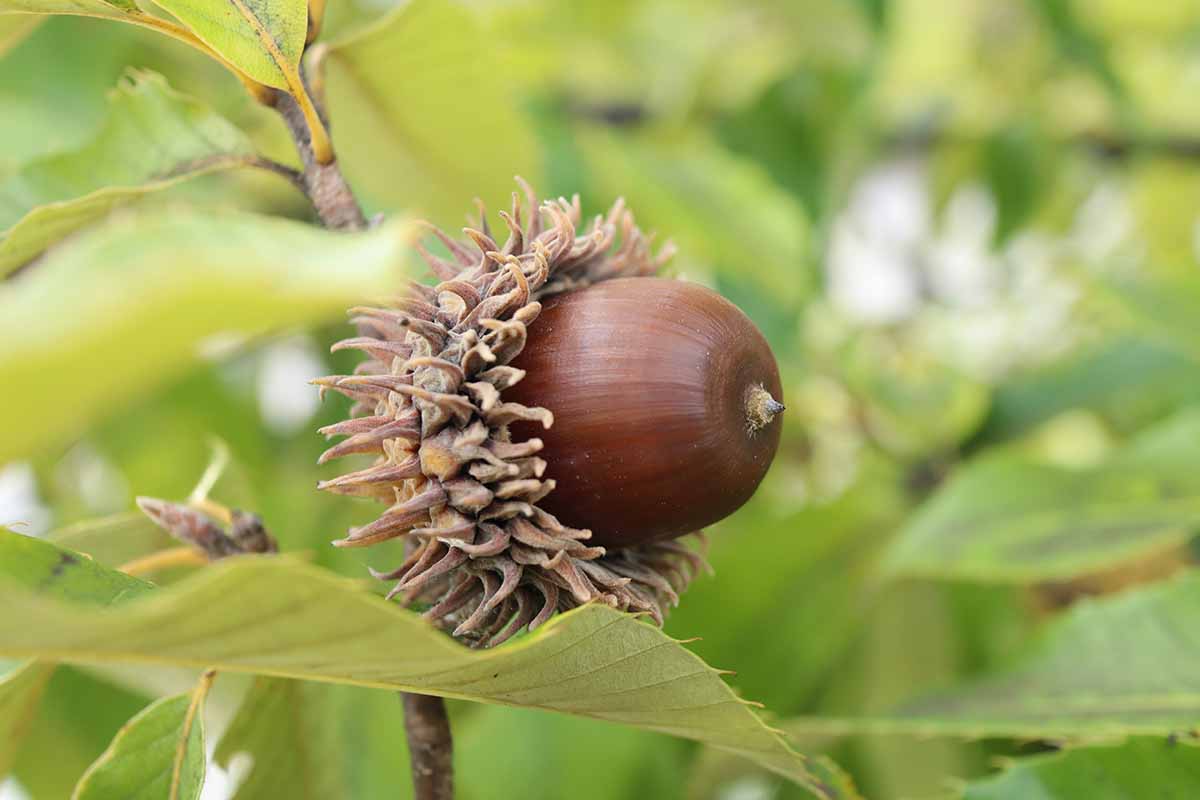
The oblong, glossy, dark green leaves have 12 to 16 prominent veins with bristles that protrude from the serrated margins.
As you could have probably guessed, each leaf has a sawtoothed appearance that’s quite easily recognizable.
The acorns are very unique, too – up to two-thirds of each brown nut is covered with a shaggy-scaled gray cap.
Features at a Glance
- Height: 40-60 feet
- Spread: 40-60 feet
- Leaf Length: 3.5-7.5 inches
- Leaf Width: 1-2.25 inches
- Acorn Length: 1 inch
- Bark Color: Ash brown
- Bark Texture: Deeply furrowed and ridged
Due to its vigorous acorn production and foreign origins, this tree has invasive growing potential across the United States, and is listed as invasive in many states.
This makes knowing what it looks like important. Although Q. acutissima is a handsome tree, you’re better off selecting native oaks instead.
15. Scarlet
A member of the Erythrobalanus group, Q. coccinea hails from the eastern United States and southern Canada, and rocks a rounded, open habit.
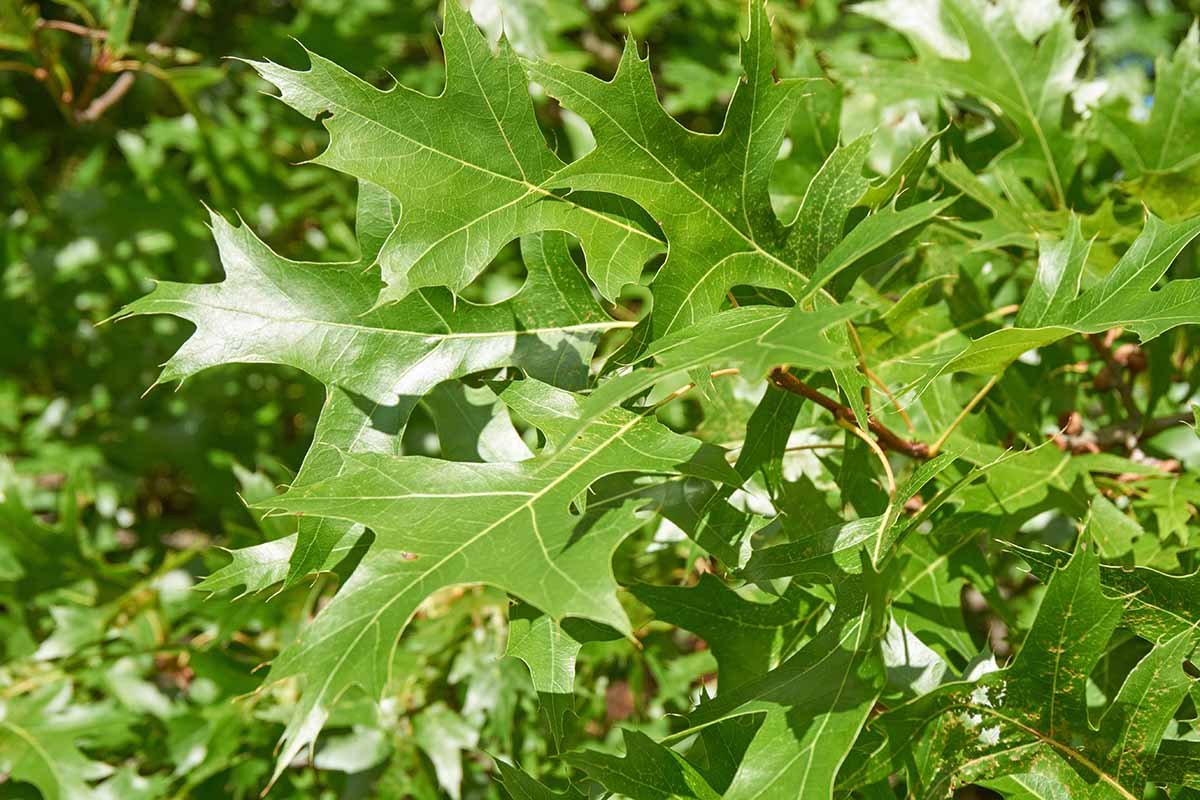
The tree flaunts glossy, dark green leaves that look like a cross between those of Q. rubra and Q. palustris, with seven to nine bristly lobes and moderately-sized sinuses.
The top third to half of the reddish-brown nuts are covered with a brownish-tan cap, and there’s a distinctive ring that surrounds each acorn’s point.
Features at a Glance
- Height: 50-70 feet
- Spread: 40-50 feet
- Leaf Length: 3-6 inches
- Leaf Width: 2.5-4.5 inches
- Acorn Length: 0.5 to 1 inch
- Bark Color: Gray to gray-brown
- Bark Texture: Shallowly ridged
An aesthetic, drought-tolerant planting for lawns and streets, scarlet oaks prefer full sun, acidic sandy soils, little moisture, and placement in USDA Zones 4 to 9.
16. Sessile
Q. petraea is a white oak from Europe and Western Asia, with a similarly rounded habit to that of Q. rubra.

The leaves, however, are very different – light green, oval-shaped, and with four to six pairs of rounded lobes.
The reddish-brown acorns are long and stemless, i.e. sessile, with a tan cap spanning a third of the nut.
Features at a Glance
- Height: 60-80 feet
- Spread: 60-80 feet
- Leaf Length: 3-7 inches
- Leaf Width: 1-3.75 inches
- Acorn Length: 1 inch
- Bark Color: Dark gray
- Bark Texture: Deeply fissured
This tree is not very common in US cultivation, but it’s a delight for those who happen to stumble across it.
It’s definitely more beloved across the pond, though – it’s the national tree of Ireland!
17. Shingle
A tree that’s native to the eastern half of the US, Q. imbricaria has a conical form that broadens with age.
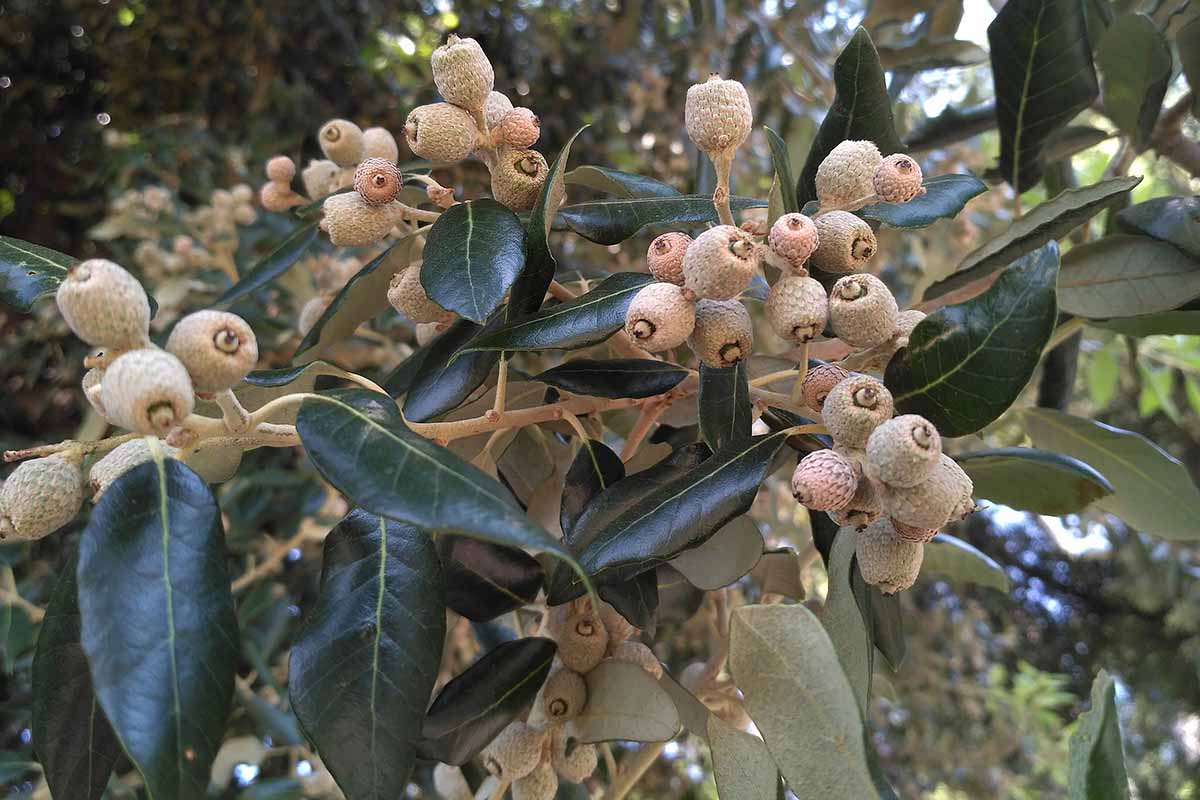
The lance-shaped, glossy dark green leaves have a bristly tip, a nod to its Erythrobalanus membership, while its rounded, dark brown acorns are covered less than halfway with a tan cap.
Features at a Glance
- Height: 40-60 feet
- Spread: 40-60 feet
- Leaf Length: 1.25-4 inches
- Leaf Width: 0.5-2 inches
- Acorn Length: 0.625 inches
- Bark Color: Brownish gray
- Bark Texture: Shallowly furrowed
Species of Quercus don’t usually make for great hedges, but Q. imbricaria is a delightful exception.
With long-lasting, dense foliage and a high tolerance for pruning, shingle oaks can function in the landscape as stupendous screens!
Be sure to provide full sun, moderate moisture, and rich soils that drain well in USDA Zones 5 to 8.
18. Shumard
An Erythrobalanus species from the southeastern United States, Q. shumardii has a pyramidal, open crown in its youth that broadens with age.
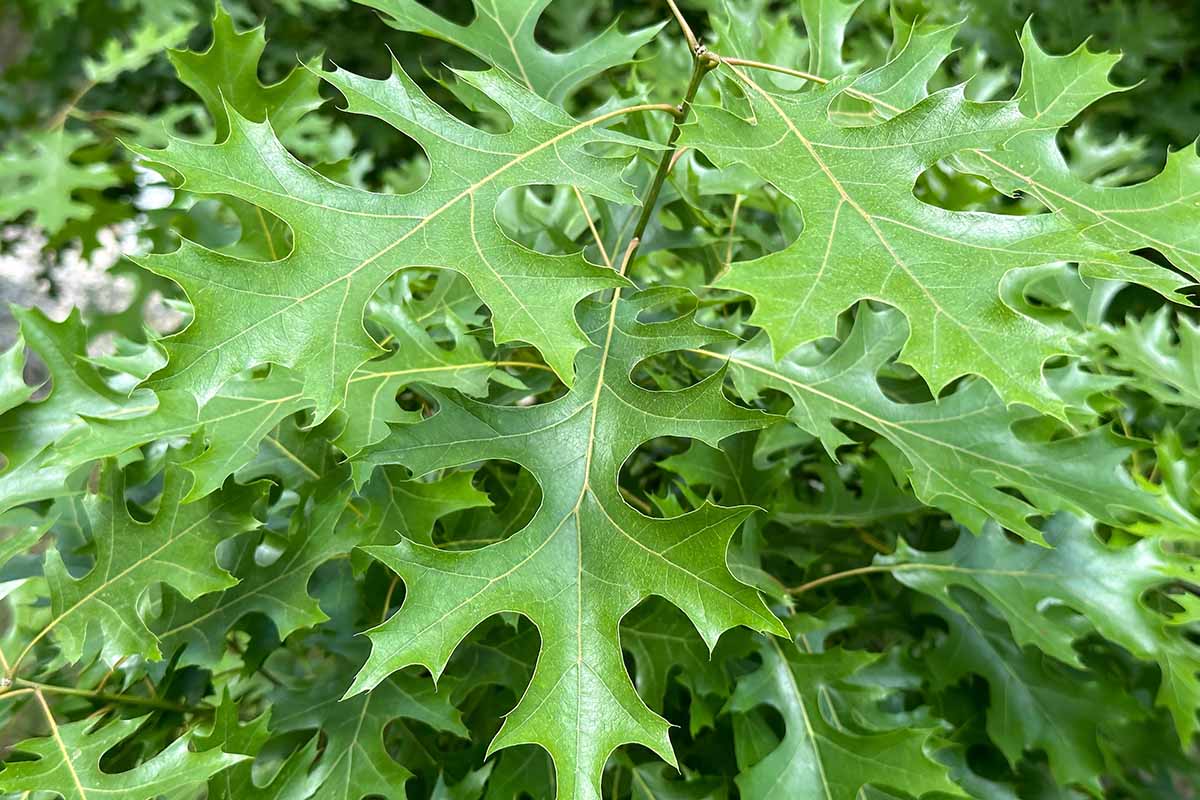
Sprouting from said crown are leathery green leaves with seven to nine bristly lobes and deeply-cut sinuses. The base of each oval-shaped, dark brown acorn is covered by a broad, tan cap.
Very similar to scarlet oaks, shumard oaks are best differentiated by looking at their buds, which are more sharply pointed.
Features at a Glance
- Height: 40-60 feet
- Spread: 30-40 feet
- Leaf Length: 6-8 inches
- Leaf Width: 3-4 inches
- Acorn Length: 0.75-1.5 inches
- Bark Color: Gray
- Bark Texture: Furrowed
Any interested growers in USDA Zones 5 to 9 should be sure to provide full sun, while a variety of soils and moisture levels are tolerable.
Shumard oak transplants are available in four- to seven-foot sizes from PlantingTree.com.
19. Southern Red
Also known as the Spanish oak, Q. falcata is an Erythrobalanus type with a rounded habit that hails from the southeastern US.
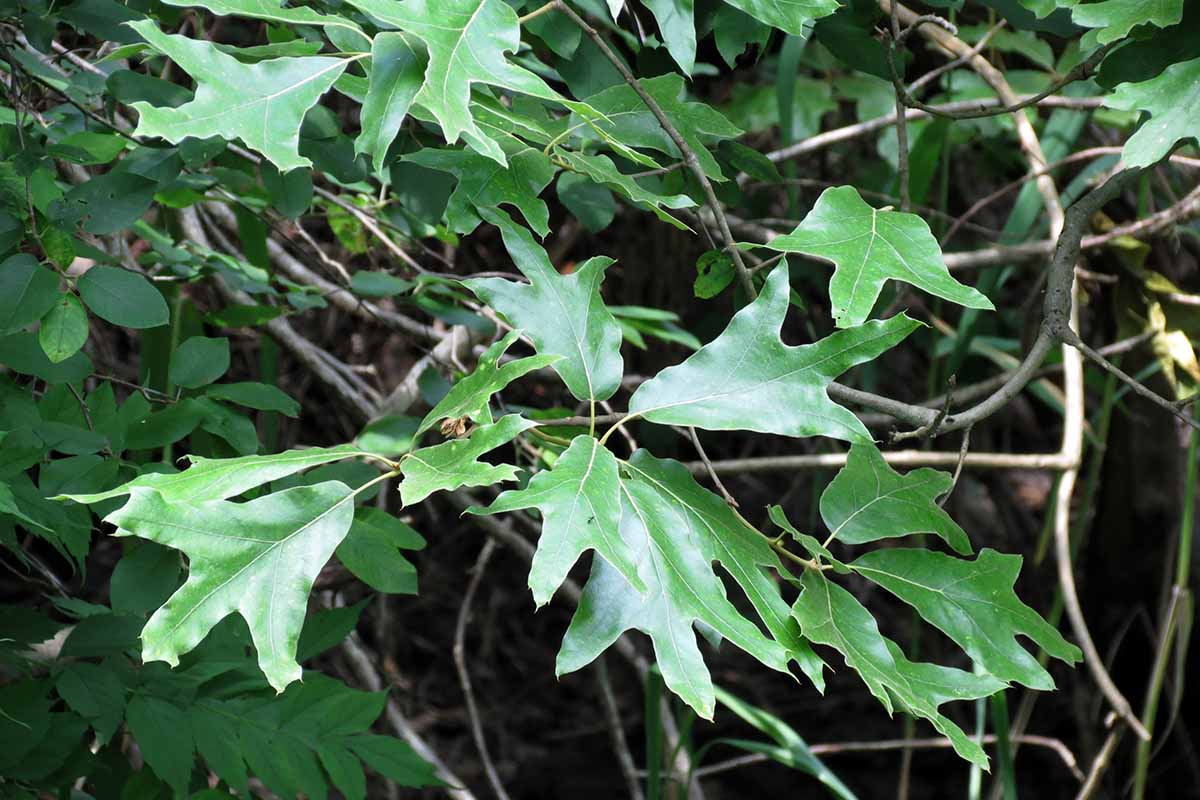
The foliage is dark green up top, pale green below, and the lobe count varies wildly, with three to nine bristle-tipped lobes per leaf.
The small, globe-shaped acorns are vertically striped with alternating strips of light and dark brown.
Features at a Glance
- Height: 60 to 80 feet
- Spread: 40 to 50 feet
- Leaf Length: 4-9 inches
- Leaf Width: 4-5 inches
- Acorn Length: 0.5 inch
- Bark Color: Gray
- Bark Texture: Ridged
Not a common commercial planting, it works quite nicely in the south, as you probably could have guessed.
20. Swamp White
A swamp-loving member of the white oak group, Q. bicolor earned its species epithet from the way its oblong, coarsely-toothed leaves are light green on top, and practically silver underneath.
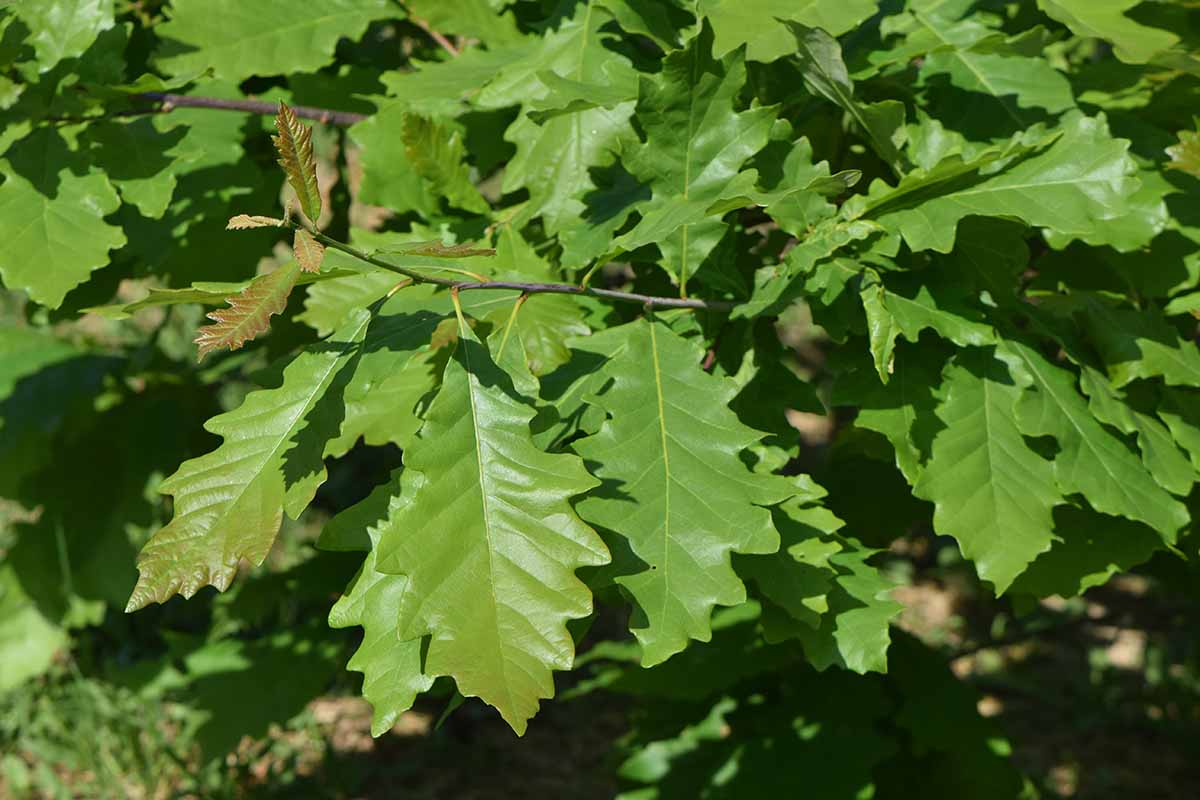
With a short trunk and a rounded, broad crown, this tree produces light brown acorns, with a brownish-tan cap on the top third of each.
Features at a Glance
- Height: 50-60 feet
- Spread: 50-60 feet
- Leaf Length: 3-7 inches
- Leaf Width: 1.25-4 inches
- Acorn Length: 1 inch
- Bark Color: Gray
- Bark Texture: Moderately furrowed
This species from northeastern North America is a perfect planting for low, wet spots in the landscape, although it can tolerate drought, as well.
Be sure to give this variety the ol’ full sun treatment that oaks love.
21. Water
Hailing from the southeastern US, Q. nigra has a form which varies from conical to round-topped.
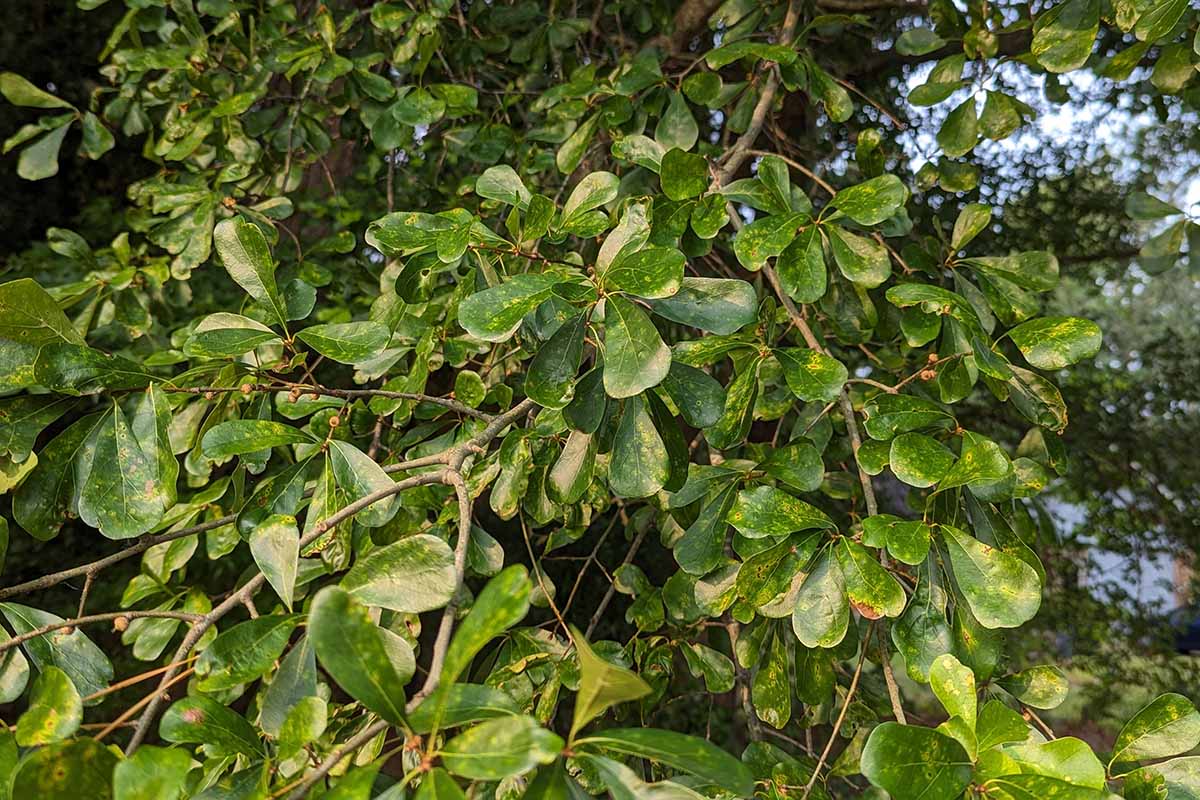
Belonging to the red oak group, this tree wields blue-green to green leaves that are actually quite variable in shape and dimensions, but they usually have three lobes towards the apex which give the foliage a uniquely club-like shape.
Additionally, the dark acorns are striped in alternating hues of brown and black, with a light brown cap covering the top quarter to third of each nut.
Features at a Glance
- Height: 50-80 feet
- Spread: 40-60 feet
- Leaf Length: 1.5-4 inches
- Leaf Width: 0.5-2 inches
- Acorn Length: 0.5 inch
- Bark Color: Light to dark gray
- Bark Texture: Shallowly furrowed
With a name like “water oak,” this tree will thrive in moist spots within the landscape.
Add full sun, rich soils, and a location somewhere in USDA Zones 6 to 9 to the mix, and you’ve got one happy tree.
22. White
As closely adhering to the qualities of a Leucobalanus as an oak can be, Q. alba is a tree from the eastern United States that starts out pyramidal, growing rounded and spreading imposingly wide with maturity.
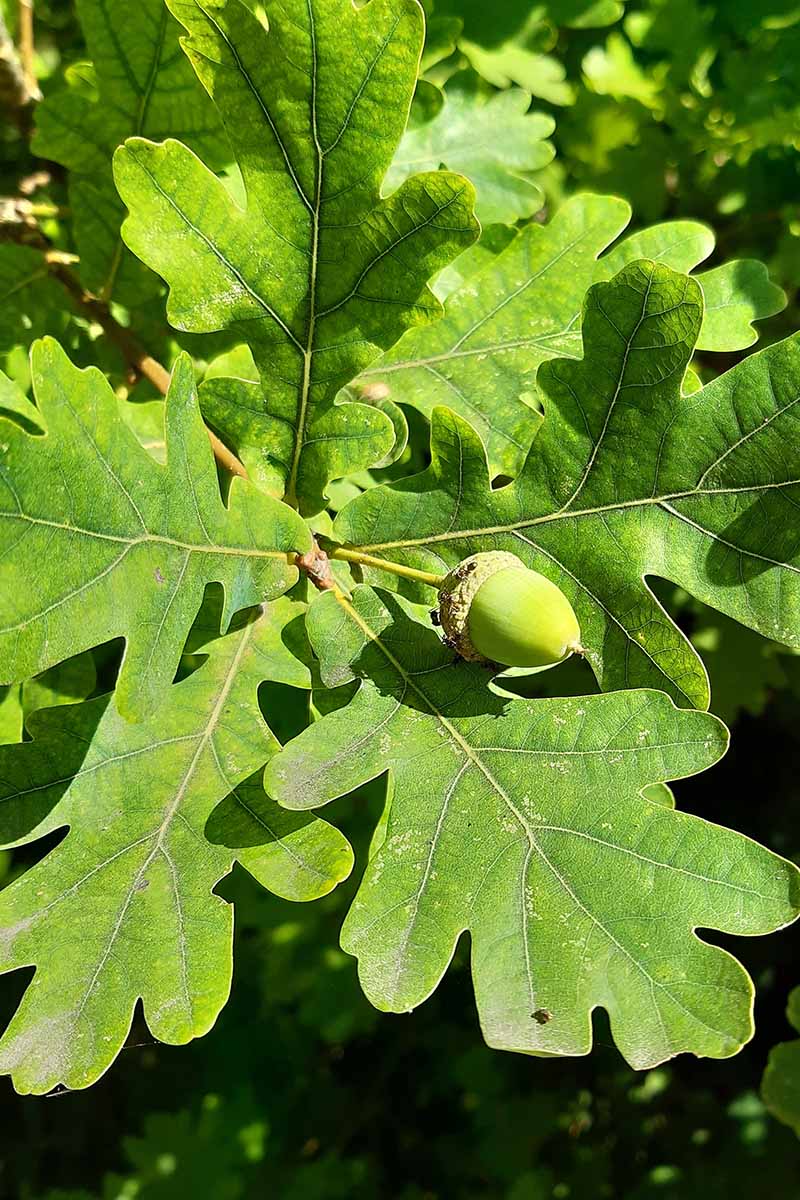
The dark green to blue-green leaves of the white oak are oblong to obovate, with about five to nine rounded lobes and narrow, yet deeply-cut sinuses.
The ovate, light brown acorns are covered with a tan, warty-scaled cap that extends a third of the way down.
Features at a Glance
- Height: 50-80 feet
- Spread: 50-80 feet
- Leaf Length: 4-9 inches
- Leaf Width: 2-4.5 inches
- Acorn Length: 0.75-1 inch
- Bark Color: Gray
- Bark Texture: Scaly, irregularly plated
Slow to grow and tough to cultivate, this is not the best selection for landscaping, although it’s quite attractive.
But its lumber – and generally that of the entire Leucobalanus group, by the way – is quite resistant to moisture absorption.
Here in Missouri, Q. alba is highly valued for its utility in making wine barrels, fun fact.
23. Willow
Another tree from the red oak group that’s native to the southeastern United States, Q. phellos has a common name that’s easy to explain, what with its skinny, lance-shaped, green leaves that very much resemble willow foliage.
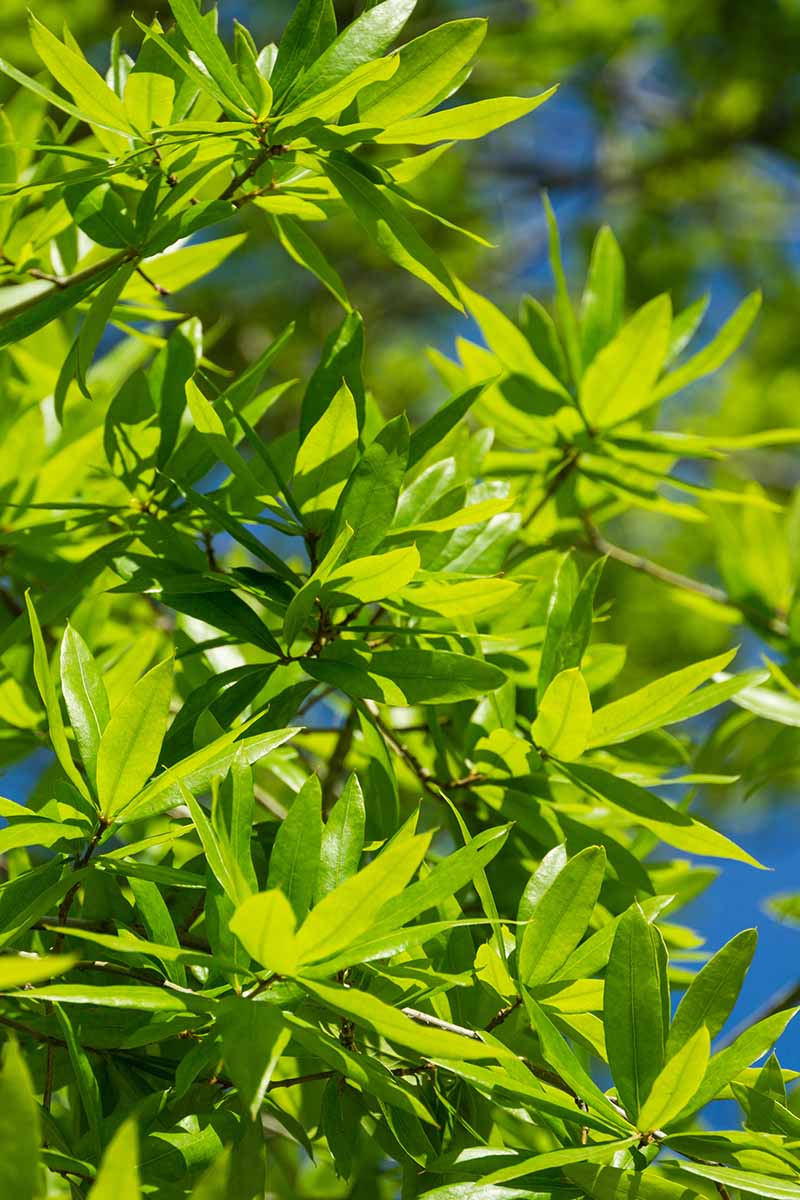
The small acorns of this dense, rounded tree are topped with a thin, saucer-like cap and striped with alternating bands of brown and black.
Features at a Glance
- Height: 40 to 75 feet
- Spread: 25 to 50 feet
- Leaf Length: 2-5.5 inches
- Leaf Width: 0.33-1 inch
- Acorn Length: 0.5 inches or less
- Bark Color: Gray
- Bark Texture: Furrowed and ridged
Most oak trees have leaves that are pretty big – “large” is the ornamental strength of many a Quercus, after all.
But if you’re looking for a thinner-leaved variety, the willow oak is the perfect tree for the job.
Give it full sun and well-draining loams in USDA Hardiness Zones 5 to 9, and it’ll absolutely flourish.
If you want a Q. phellos transplant in a starting size of four to seven feet, check out PlantingTree.com.
A-Oak-Kay
How’s that for an oak tree guide, huh? Enough to kick-start a love of the Quercus genus, I hope.
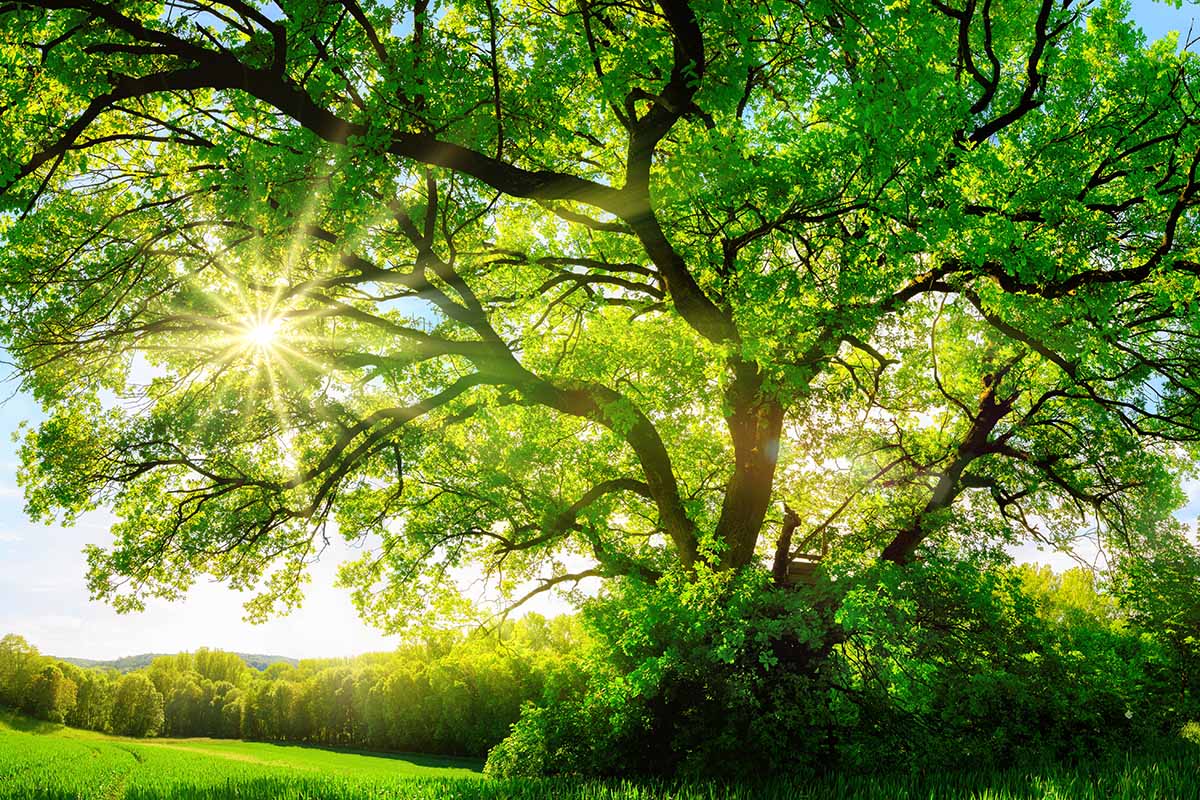
There are many oak trees to discover and identify, so keep your eyes peeled when you’re out and about. And if you’ve decided to grow one in your landscape, then kudos to you!
Questions, comments, oak ID tips that you’ve learned? Put ’em in the comments section below.
Have a ton of mental storage for landscape tree varieties? These guides are sure to fill up those databanks:
